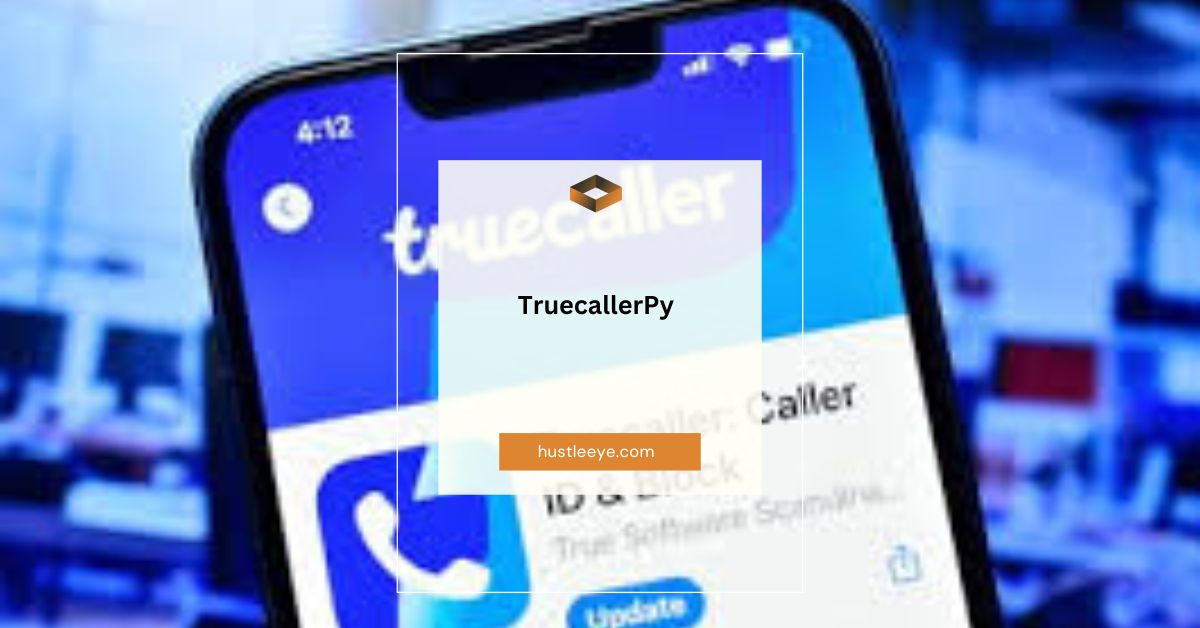In today’s fast-paced digital world, communication is key. Whether you’re developing a mobile app or a web service, ensuring seamless and secure communication with users is crucial. This is where TruecallerPy steps in—a Python package that simplifies working with the Truecaller API, enabling developers to effortlessly integrate caller identification, spam prevention, phone number validation, OTP (One-Time Password) verification, and secure login features into their projects.
This article will walk you through everything you need to know about TruecallerPy, from installation and configuration to its core features and real-world applications. Whether you’re a seasoned Python developer or just starting out, this comprehensive guide will help you leverage the power of TruecallerPy in your projects.
Table of Contents
What Is TruecallerPy?
TruecallerPy is a Python library designed to interact with the Truecaller API, which provides caller identification, spam detection, and verification services. TruecallerPy simplifies the integration of these features into your Python-based applications. Developers can access Truecaller’s vast database of phone numbers and utilize its capabilities to enhance user authentication, secure logins, and streamline communication within apps.
1. Why Use TruecallerPy?
TruecallerPy allows developers to:
- Verify phone numbers: Validate user-provided phone numbers to ensure accurate data collection.
- Prevent spam: Identify and block spam numbers to enhance user experience.
- Enable secure login: Simplify the login process by using Truecaller’s secure login mechanism.
- Use OTP verification: Securely verify user identity with OTP.
TruecallerPy makes integrating these features straightforward, eliminating the need for complex API management and allowing developers to focus on building innovative solutions.
Read More: Katt Williams Net Worth: A Deep Dive into the Legendary Comedian’s Fortune
Key Features of TruecallerPy:
TruecallerPy is packed with features designed to improve communication and security in your apps. Here’s a detailed look at its most useful functions:
1. Phone Number Validation:
One of the main features of TruecallerPy is phone number validation, which helps ensure that only valid phone numbers are used within your application. By cross-referencing user-provided phone numbers with Truecaller’s extensive database, TruecallerPy ensures the integrity of your data. This feature is particularly useful for applications that rely on accurate contact details, such as e-commerce platforms or social media apps.
Example Use Case: An online store that requires customers to provide valid phone numbers for order tracking and notifications.
2. OTP Verification:
In today’s security-conscious world, OTP verification is a must for apps that handle sensitive user data. TruecallerPy integrates seamlessly with the Truecaller API, enabling developers to implement secure OTP verification procedures. This feature boosts the security of user authentication, ensuring that only legitimate users can access their accounts.
Example Use Case: A banking app that uses OTP verification to confirm transactions and prevent unauthorized access.
3. Secure Login Integration:
TruecallerPy also supports login integration, allowing developers to incorporate Truecaller’s secure login functionality into their apps. This feature streamlines the login process while ensuring that user data remains secure. By leveraging TruecallerPy, developers can offer a smooth, user-friendly login experience without compromising on security.
Example Use Case: A social networking app that uses Truecaller’s login integration to allow users to sign in securely without needing multiple passwords.
Read More: Harriet Tendler: A Life of Art, Resilience, and Inspiration
Installing and Setting Up TruecallerPy:
Now that you’re familiar with the key features of TruecallerPy, let’s walk through the installation and setup process.
1. Prerequisites:
Before installing TruecallerPy, make sure you have the following:
- Python 3.x: The package is compatible with Python 3.x.
- Pip: The Python package installer.
2. Installation:
To install TruecallerPy, open your terminal or command prompt and run the following command:
bash
Copy code
pip install truecallerpy
This command will install TruecallerPy along with all its dependencies.
3. Configuration:
After installing the package, you’ll need to configure it with your Truecaller API credentials. These credentials allow your app to interact with the Truecaller service.
Follow these steps to configure TruecallerPy:
- Obtain API keys from Truecaller by signing up for their API service.
- Use the API keys in your Python script to authenticate and interact with Truecaller’s services.
For more detailed configuration instructions, refer to the official TruecallerPy documentation.
Read More: Sugarhill Ddot Age: The Story of a Rising Star
Best Practices for Using TruecallerPy:
To get the most out of TruecallerPy, follow these best practices:
1. Secure Your API Credentials:
Always store your API credentials securely. Avoid hardcoding them into your script. Instead, use environment variables or a secure credential management system to protect sensitive information.
2. Monitor API Usage:
Truecaller’s API has usage limits, which may affect how many requests your app can make within a given period. Regularly monitor your API usage to avoid service disruptions. Some monitoring tools can help you track performance and usage in real-time.
3. Implement Error Handling:
When working with external APIs like Truecaller, there is always a chance of encountering errors, such as network issues or invalid API requests. Implement robust error handling in your app to manage these situations gracefully and ensure a smooth user experience.
Read More: Âmni: Revolutionizing Digital Innovation in the USA
Limitations of TruecallerPy:
While TruecallerPy offers many advantages, it also has some limitations:
1. API Usage Restrictions:
The Truecaller API has usage limits, which may restrict the number of requests your app can make. Be aware of these limitations and monitor your app’s API usage to prevent interruptions.
2. Data Privacy Concerns:
Handling user data requires strict adherence to privacy laws and regulations. Ensure that your app complies with data protection regulations, such as GDPR, when using TruecallerPy to handle user information.
3. Dependency on External Services:
TruecallerPy relies on the Truecaller API. Any changes or disruptions to the API could impact your app’s functionality. It’s essential to keep track of updates or changes to the Truecaller API and adjust your app accordingly.
Read More: FintechZoom GM Stock: A Comprehensive Analysis and Investment Guide
Alternatives to TruecallerPy:
While TruecallerPy is a powerful tool, it might not be the best fit for every project. Here are some alternatives you can consider:
1. Google Phone Verification API:
Google’s Phone Verification API offers similar functionality for phone number validation and OTP verification. It’s widely used and well-documented, making it a reliable alternative to TruecallerPy.
2. Twilio:
Twilio provides a full suite of communication APIs, including phone number validation and OTP services. Twilio is known for its reliability, scalability, and extensive documentation, making it an excellent choice for larger projects.
3. Nexmo (Vonage API):
Nexmo, now part of Vonage, offers a range of communication services, including phone number validation and OTP verification. It is designed for handling large volumes of communication requests and is often used by enterprise-level applications.
Read More: The Comprehensive Guide to Mikayla Campinos: Age, Journey, and Impact
Real-World Applications of TruecallerPy:
TruecallerPy is versatile and can be used in a wide variety of applications. Here are some real-world use cases where TruecallerPy shines:
1. User Authentication:
TruecallerPy simplifies user authentication by validating phone numbers and securing login processes with OTP verification. This ensures that only legitimate users can access sensitive data or features.
Example: An online payment gateway that requires users to verify their identity via OTP before making transactions.
2. Fraud Prevention:
By validating phone numbers and checking them against Truecaller’s spam detection database, TruecallerPy can help prevent fraudulent activities. This is especially useful in industries like e-commerce and online banking, where fraud prevention is critical.
Example: A ride-sharing app that verifies the phone numbers of both drivers and passengers to ensure safe and legitimate transactions.
3. Data Quality Assurance:
For apps that rely on user data, such as contact information or account details, TruecallerPy ensures the quality of the data by validating phone numbers before they are entered into the system. This improves the overall reliability of the app’s functionality.
Example: A CRM system that uses TruecallerPy to validate customer phone numbers, ensuring that sales teams are contacting legitimate leads.
Read More: Local Survivable Processor (LSP): Everything You Need to Know
Conclusion: Why TruecallerPy Is Essential for Modern Communication
TruecallerPy is a must-have tool for Python developers looking to integrate Truecaller’s advanced services, such as phone number validation, OTP verification, and secure login, into their projects. With its ease of use, robust feature set, and the ability to enhance communication and security, TruecallerPy empowers developers to build reliable and user-friendly applications.
By understanding its features, limitations, and best practices, you can leverage TruecallerPy to create innovative, secure, and efficient apps that stand out in today’s competitive digital landscape.
FAQs About TruecallerPy:
1. What is TruecallerPy?
TruecallerPy is a Python package that allows developers to interact with the Truecaller API, enabling features like caller identification, phone number validation, and OTP verification.
2. How do I install TruecallerPy?
You can install TruecallerPy by running the command pip install truecallerpy in your terminal or command prompt.
3. Can I use TruecallerPy for secure login?
Yes, TruecallerPy supports login integration, allowing you to implement Truecaller’s secure login mechanism in your app.
4. Is TruecallerPy free to use?
TruecallerPy itself is free to use, but the Truecaller API may have usage limits and fees depending on the service plan you choose.
5. What are the alternatives to TruecallerPy?
Alternatives include Google’s Phone Verification API, Twilio, and Nexmo (Vonage API), which offer similar services for phone number validation and OTP verification.
6. Does TruecallerPy comply with data privacy regulations?
While TruecallerPy provides the tools for handling user data, it is the developer’s responsibility to ensure that their app complies with local and international data privacy laws, such as GDPR in the European Union or CCPA in California. Always follow best practices for securing sensitive user information.
7. What are the primary features of TruecallerPy?
TruecallerPy’s key features include phone number validation, OTP (One-Time Password) verification, spam detection, and secure login integration with the Truecaller API.
8. Can TruecallerPy help prevent fraud?
Yes, TruecallerPy can help prevent fraud by verifying phone numbers and cross-referencing them with the Truecaller database, ensuring that only legitimate numbers are allowed to interact with your app.
9. Is TruecallerPy suitable for small projects?
TruecallerPy can be used in both small and large projects. For smaller projects, it provides an easy way to add secure communication features, while in larger projects, its scalability and integration with Truecaller’s API make it a reliable option.
10. What should I do if the Truecaller API has service interruptions?
As TruecallerPy depends on the Truecaller API, any disruption in the API service could affect your app. It’s important to implement fallback mechanisms in your app to handle API errors gracefully and ensure a smooth user experience.
Final Thoughts:
TruecallerPy is a powerful and easy-to-use Python package that helps developers integrate essential communication and security features, such as phone number validation, OTP verification, and secure login, into their applications. By using TruecallerPy, you can enhance the security, reliability, and user-friendliness of your app while avoiding the complexities of directly managing the Truecaller API.
With its straightforward installation and rich feature set, TruecallerPy is a go-to solution for developers who want to improve the communication capabilities of their apps. Whether you’re building a small project or scaling up to handle large user bases, TruecallerPy will help you maintain the integrity of your app’s data and provide users with a safe, seamless experience.
By adhering to best practices, monitoring API usage, and staying compliant with data privacy regulations, you can ensure that your app benefits from all the advantages TruecallerPy offers while mitigating potential challenges. Now is the time to explore TruecallerPy and discover how it can revolutionize the way you handle communication in your Python projects.


